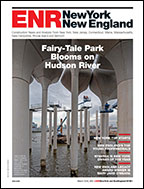Hudson River Park Segment 3, New York, N.Y.
As New Yorkers regain access to their rivers, Hudson River Park has been a signature success, running from Battery Park City north for 5.5 miles along an uninterrupted causeway for pedestrians and cyclists. But the work is far from over, as the park’s newest addition, Segment 3, added a mile-long stretch of nature walks, recreational and sport fields (including miniature golf, sand volleyball and a concrete skate park), a playground and a boathouse. Additionally, the project saw the creation of two piers, occupying 21 acres of upland and pier space, as well as 90 acres of “safe water” for boating.

“The logistical issues with marine work mean that you can’t work in extreme tides typically,” says Tom Purcio, project manager for Turner Construction, the construction manager on the $120 million project. “And anything that disturbs the water can’t be done during the winter months, so all fabrication was set up to go in the spring.”
The Army Corps of Engineers, with respect to regulations on fish spawning, was able to squeeze all marine work in between May 1 and Nov. 1. The proximity of Trans-Hudson ConEd cables to piers 25 and 26 meant the 500-600 new piles needed for the piers had to be drilled rather than driven. This respect for marine life went even further as the demolished concrete from the site, about five barges-worth, instead of going to a landfill, was used to make New Jersey into a possible diving destination by creating an artificial reef.
On land, the marine nature of the park meant selecting materials capable of withstanding salt spray, periodic flooding, and even hurricane-force gales.
In addition, the 5.5-mile promenade was required to stay open during construction, which meant constant adjustment of fencing and the use of flagmen. The tightness of the site, bound by the West Side Highway, made sequencing of construction segments particularly important.
As a green space, the park is also a study in sustainability. Forest Stewardship Council-certified wood for the boardwalks, concrete base with high fly ash content, recycled concrete under pavements, locally sourced limestone and bluestone, and dark-sky-comliant lighting. Storm-water runoff is filtered through the planting beds before going into the river.
Landscape designers had to be careful about the seasonality of the plantings (96% of which are native) and coordinated with the construction crews to meet their schedules. The soil was manufactured to best suit the components of each section. Finally, about a half-mile of a Civil War-era granite bulkhead required refurbishments to be pre-approved prior to any modifications or additions.
“The new piers, the locally sourced stone are all very interesting and unique stuff,” Purcio says. “But for us at Turner, what is most unique is leaving behind this legacy as local residents, to enjoy it on a personal level. It’s for everybody, not just to serve our clients, but to make the city better.”
Key Players
Developer/Owner: Hudson River Park Trust
General Contractor: J. D’Annunzio & Sons, Clark, N.J.
Construction Manager: Turner Construction, New York*
Architect: Mathews Nielsen Landscape Architecture, New York
*Submitted Project to New York Construction


